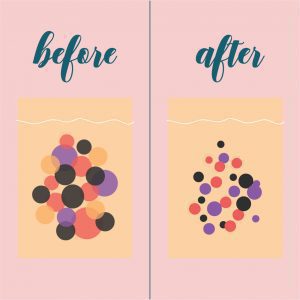What should you know before getting Tattoo Removal

While a lot has been written about tattoos and what you need to consider before getting them. A major concern in getting tattoos, is that it will be permanent. If you are having tattoo regrets, you are not the first one to have second thoughts about them, whether it was a rash decision, or you no longer love the design you had picked out in your twenties, you’ll be happy to hear that despite tattoos being permanent, there is a way to get them removed aesthetically. Introducing, laser tattoo removal and all the stigma surrounding it.
Let’s address whether its possible to remove tattoos completely. There are certain things that a doctor has to consider, firstly, it depends on the colour and type of ink being used, another thing that needs to be considered is your skin tone.
In certain cases, laser tattoo removal is able to remove the tattoo completely but it may result in getting white patches (hypopigmentation) or getting darker patches (hyperpigmentation). The process will take a minimum of 6-8 sessions, in some cases more sessions will be required, it is a long process (so gear yourself mentally for the long haul).
The Process:
- If you have hair on the area of the skin that needs to be treated, you need to shave before the appointment.
- Prior to the treatment, numbing cream will be applied.
- After 30 minutes the numbing cream has taken effect, the laser removal can begin.
- A Zimmer cooling machine will be used to blow chill air and provide comfort to the patient during the laser process.
- The laser treatment works by breaking down the tattoo ink which shatters into tiny fragments, which will eventually be absorbed into the bloodstream and safely passed out of the body
- The laser hand-piece is held 1 – 2 inches away, the laser beam will then penetrate the skin without any contact, hence there will be no skin damage. The sensation of the laser would be akin to elastic band snapping at your skin.
- The laser process will normally take 10 – 15 minutes, depending on the size of the tattoo it could take longer.
- The tattoo should become progressively lighter with each treatment
- Generally, a tattoo will need 6 – 8 sessions before it is removed completely. There are instances where more sessions are needed.




After Treatment:
- After getting laser tattoo removal, do not be alarmed if you experience redness and swelling on the skin. Holding an ice pack to the treated area may help (ensure that it is wrapped in a towel).
- Your skin will be more sensitive to the sun, so you will need to avoid sun exposure and tanning for at least a week. Reapply sunscreen as often as you can.
- Regular application of aloe vera gel, and Vaseline may help with blistering or scabbing.

What are other factors that may affect the tattoo removal process?
There are multiple factors that determine the efficiency of the tattoo removal.
- Skin tone. The darker your skin, the higher your risk of hyperpigmentation (darker patches). The setting for laser should be lowered to combat this issue.
- Tattoo ink. The older it is, the easier it will be to remove, this is due to the ink sinking and being embedded into the skin, thus making it appear more faded.
- Tattoo colours. Black ink is easier to remove than bright colours. Green and blue tend to be challenging. Other colours such as yellow, white and purple are almost impossible to remove completely. Different wavelengths of laser target different colours in the skin, so it makes sense that several lasers would be required to successfully remove a multicoloured tattoo.
- Multiple layers of tattoos (for example to cover up). If you have more layers of tattoos, it will be hard to remove the layers.
- Location of tattoo also plays a role on the removal process. Fading is generally slower if the tattoo is located further down the arms or legs as they are further from the heart. The closer the tattoo is to the heart, the better the circulation, therefore, the better the results.
- After Care. It plays a very important role in tattoo removal. Blistering and scabs are quite common after the tattoo removal process, its important not to pick at the scabs as it will take a longer time to heal.

 .
. 
An important thing to note, it is vital to have a discussion with your Doctor on your expectations. Whether it is a complete removal, for it to fade off, or whether you are planning to cover up with a tattoo.
There is an increase in unverified clinics and beauty centres offering tattoo removal services at cheaper price. Be careful of centres offering a deal that is too good to be true. Ensure you choose a clinic that is licensed, and the machine is FDA approved. In Beverly, we have 3 different machines that are FDA approved; Revlite, Medlite and Fotona and they are operated by a licensed physician. Things to look out for: right clinic, right laser and right practitioner who is able to answer all your queries. The wrong type of treatment can lead to permanent scarring.

Myths about tattoo removal:
Myth 1: Home remedies like acid peel and salt scrubbing can remove tattoos.
False, home remedies may do more harm than laser removal. Acid Peel/ Chemical Peel works by penetrating through your skin to interact with the ink. It works in an imprecise manner, it may or may not cause the ink to fade. Also, the moment it penetrates your skin, there is a chance that it can damage the skin around it. There is no guarantee on the removal of ink with acid/chemical peel.
Salt scrubbing doesn’t actually address the removal of tattoo ink. The theory is to use salt to scrub against the superficial part of your skin to remove the ink. However, with scrubbing, you risk tearing your skin and hygiene may be an issue.
The only FDA approved solution is to use lasers.

Myth 2: My tattoo has gotten darker after laser tattoo removal.
There is some truth to this; however, do not be alarmed as it is part of the removal process. After your first treatment, you may find that the tattoo is getting darker. Some of the ink used in tattoos, including colours containing white ink, may darken (oxidize) immediately after the treatment because of titanium dioxide. The ink contains iron, which in turn will make it darker or grey, it can be corrected with further treatments, but in the meantime it may appear darker.

Myth 3: Laser tattoo removals can cause scarring
Laser scarring is rare. The practitioner will ensure that the laser is in the correct settings, therefore limiting the occurrence of laser scarring. Unless you are prone to Keloids, or you pick at your scabs during your after care of the removal process, it should not happen.

Myth 4: Laser tattoo removal is more painful than getting a tattoo
The million-dollar question that seems to pop-up whenever anyone mentions tattoo removal. The truth is that certain areas are more sensitive than others. Areas that have fatty tissues will be more bearable.

Now we’ve cleared up some of the stigma surrounding laser tattoo removal, it’s time to fix that tattoo regret.





